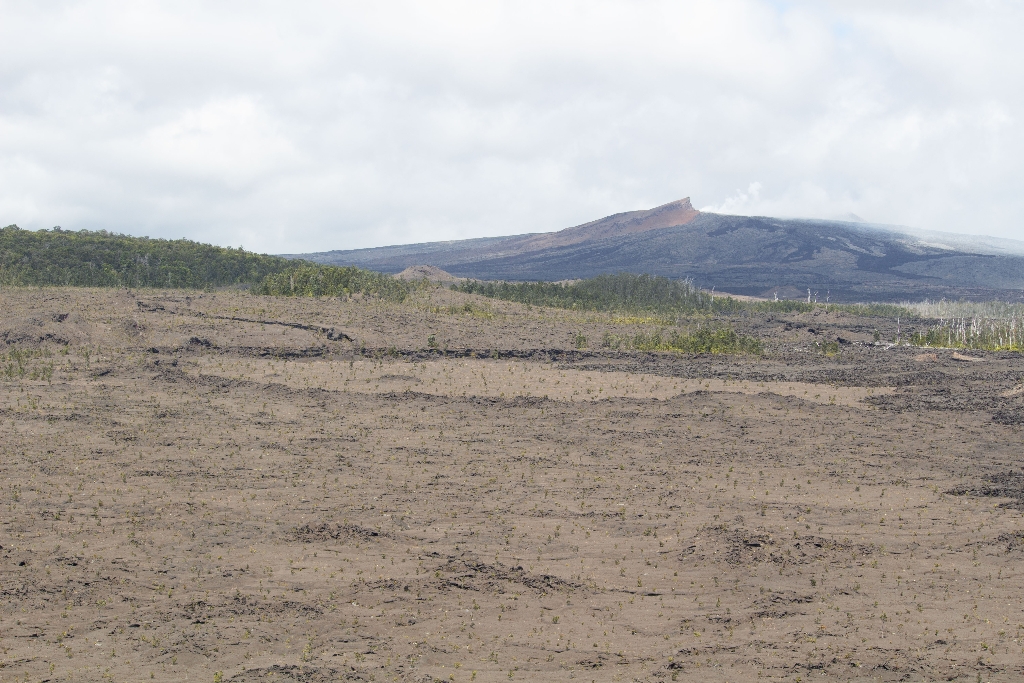
Puʻuʻōʻō
In the distance, you may be able to spot Pu‘uʻō‘ō, a cone that formed in the early years of the current eruption. It has experienced several collapses and has slowly buried itself beneath a lava shield of its own making. In 1983, the Puʻuʻōʻō eruption began seven miles farther out on the East Rift Zone and soon surpassed Maunaulu in many ways. Yet Maunaulu still holds a special place in the memories of those who witnessed the spectacular events.
Kāne nui o Hamo
The tree-covered summit of Kāne nui o Hamo lava shield can be seen infront of Puʻuʻōʻō. Kāne nui o Hamo is pitted by a forested crater - Makaopuhi, the largest pit crater on Kīlauea. Lava erupted within—or cascaded into—Makaopuhi crater several times but filled only the deeper half of the giant pit. It was named “eye of the eel” for a lens of bluish lava that appeared on the lower crater wall.
ʻAlae
Prior to this eruption, ʻAlae crater was 0.25 mile (0.5 km) wide and over 425 feet (130 m) deep. During the night of August 4, 1969, lava filled it nearly to its rim. Four hours later, hundreds of earthquakes shook violently, a fissure opened across the crater floor, and most of the liquid lava in the crater drained away. In 30 extraordinary minutes, the lake level dropped as 13 million yards (10 million m3) of lava drained underground to emerge three miles (4.8 km) downrift in Nāpau crater. A day later, one of the most memorable spectacles of the eruption occurred when a huge lava falls cascaded into ʻAlae crater. These falls were wider and higher than the American Falls at Niagara. They soon refilled the crater. By 1974 the eruption had built its third great lava shield, rising 295 feet (90 m) above the rim of the entombed crater. Today it sits just left of where Maunaulu rises today.
In the distance, you may be able to spot Pu‘uʻō‘ō, a cone that formed in the early years of the current eruption. It has experienced several collapses and has slowly buried itself beneath a lava shield of its own making. In 1983, the Puʻuʻōʻō eruption began seven miles farther out on the East Rift Zone and soon surpassed Maunaulu in many ways. Yet Maunaulu still holds a special place in the memories of those who witnessed the spectacular events.
Kāne nui o Hamo
The tree-covered summit of Kāne nui o Hamo lava shield can be seen infront of Puʻuʻōʻō. Kāne nui o Hamo is pitted by a forested crater - Makaopuhi, the largest pit crater on Kīlauea. Lava erupted within—or cascaded into—Makaopuhi crater several times but filled only the deeper half of the giant pit. It was named “eye of the eel” for a lens of bluish lava that appeared on the lower crater wall.
ʻAlae
Prior to this eruption, ʻAlae crater was 0.25 mile (0.5 km) wide and over 425 feet (130 m) deep. During the night of August 4, 1969, lava filled it nearly to its rim. Four hours later, hundreds of earthquakes shook violently, a fissure opened across the crater floor, and most of the liquid lava in the crater drained away. In 30 extraordinary minutes, the lake level dropped as 13 million yards (10 million m3) of lava drained underground to emerge three miles (4.8 km) downrift in Nāpau crater. A day later, one of the most memorable spectacles of the eruption occurred when a huge lava falls cascaded into ʻAlae crater. These falls were wider and higher than the American Falls at Niagara. They soon refilled the crater. By 1974 the eruption had built its third great lava shield, rising 295 feet (90 m) above the rim of the entombed crater. Today it sits just left of where Maunaulu rises today.
Is there something we missed for this itinerary?
Itineraries across USA

Acadia

Arches National Park

Badlands

Big Bend

Biscayne

Black Canyon Of The Gunnison

Bryce Canyon

Canyonlands

Capitol Reef

Carlsbad Caverns

Channel Islands

Congaree

Crater Lake

Cuyahoga Valley

Death Valley

Dry Tortugas

Everglades

Gateway Arch

Glacier

Grand Canyon

Grand Teton

Great Basin

Great Smoky Mountains

Guadalupe Mountains

Haleakalā

Hawaiʻi Volcanoes

Hot Springs

Indiana Dunes

Isle Royale

Joshua Tree

Kenai Fjords

Kobuk Valley

Lassen Volcanic

Mammoth Cave

Mesa Verde

Mount Rainier

North Cascades

Olympic

Petrified Forest

Pinnacles

Rocky Mountain

Saguaro

Shenandoah

Theodore Roosevelt

Virgin Islands

Voyageurs

White Sands

Wind Cave

Yellowstone

Yosemite

Zion